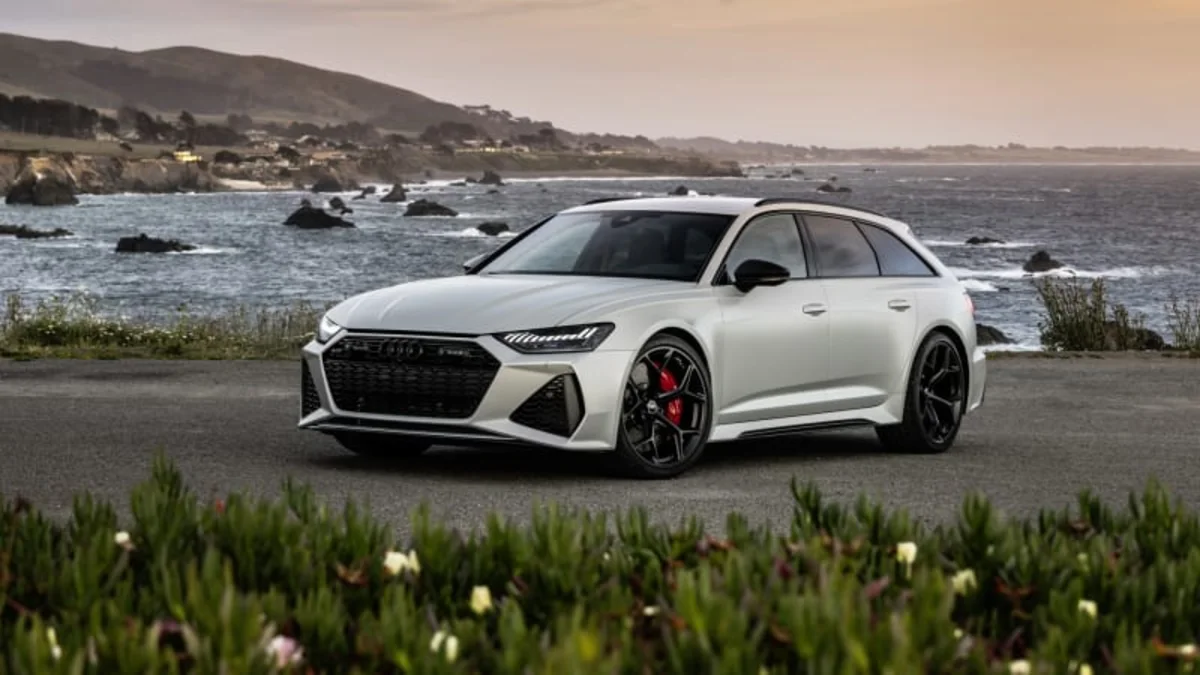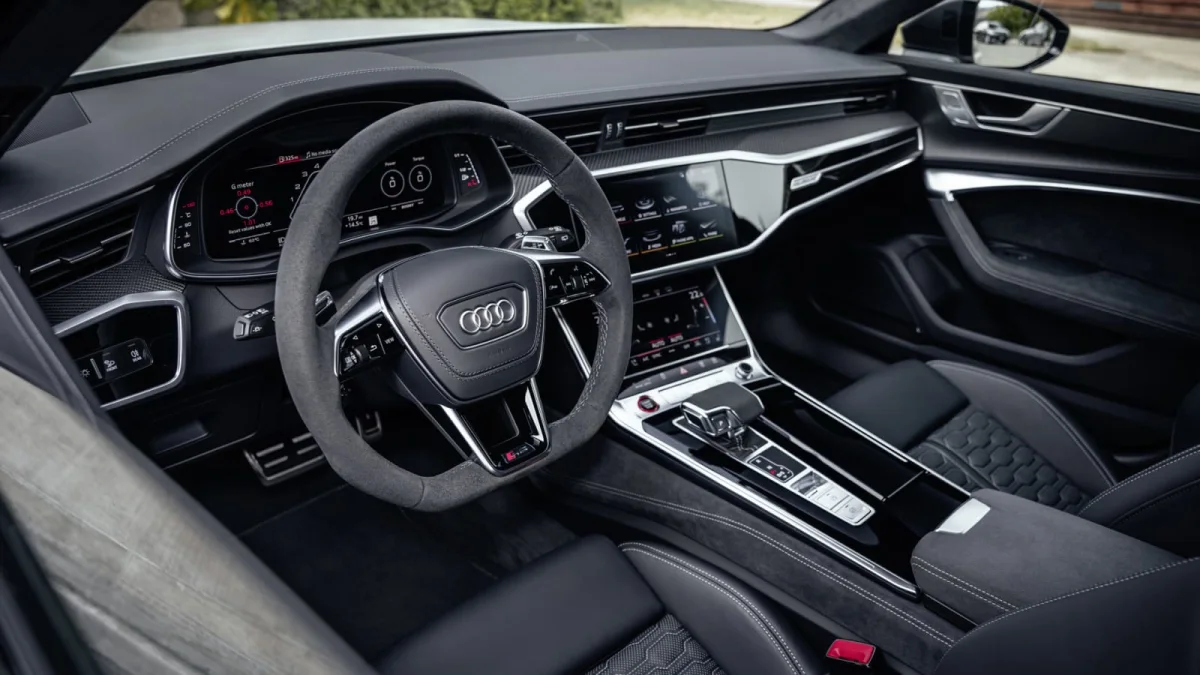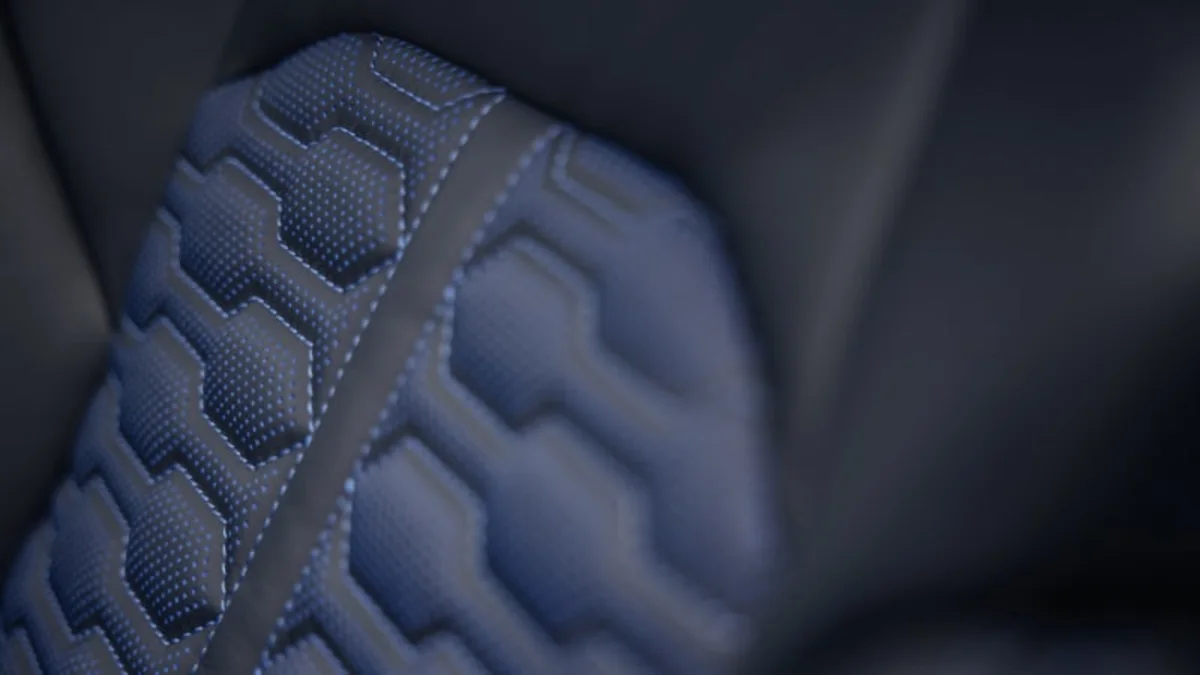The Audi RS 6 Avant and its RS 7 Sportback sibling aren’t exactly cars you buy because you’re thinking with the logical side of your brain. Yet, customers have apparently been longing for a more emotional driving experience, or “emotionality” as the Germans prefer to Scrabble together, so that’s exactly what we’re getting with the new 2024 Audi RS 7 Performance and RS 6 Avant Performance.
Sound deadening has been ripped out to better hear the V8’s mechanical wail and the optional sport exhaust’s nasty snarl and crackles (it cuts 17.6 pounds, too). The eight-speed transmission snaps off quicker shifts thanks to updated software, especially in its “Dynamic” mode. Oh, and there’s 30 more horses, 37 more pound-feet of torque and two-tenths of a second chopped off the 0-60-mph time. The 4.0-liter V8’s twin turbochargers are bigger and operate at a higher boost pressure, resulting in 621 hp, 627 lb-ft of torque and the 3.3-second 0-60 time. Launching the car like that still proves a challenge for the also-new Continental Sport Contact 7 tires, which desperately claw at the pavement. You can feel the subtle twitching at all four corners before full grip is achieved and you disappear into the distance to a chorus of angry exhaust.
Is all of that emotional? Why not? It certainly ain’t boring. Some of the newfound emotionality is also achieved thanks to an enhanced sense of fashion and greater customization. The exterior color palette has been updated with the vibrant Gerenadier Red metallic and Ascari Blue metallic, plus matte versions of Ascari Blue pictured here on the RS 7 and Dew Silver pictured on the RS 6 Avant. A new matte gray exterior trim is applied as standard to the mirrors, front spoiler, side sill inserts, roof rails (Avant), rear diffuser and window trim. All of that was a brighter alloy finish before. You can still get the Black optic package, however, which makes it all gloss black along with the badges. That’s an extremely popular option throughout Audi’s lineup, even if it makes it look like someone stole the chrome rings off the front of your car.

The interior sees an additional customization option for the all-digital instruments: a white background can be swapped in place of the standard black, harkening back to the original RS car, the 1997 S6 plus. We don’t actually know what they look like since the cars on hand didn’t have them (long story, it has to do with model years and Europe), though by the sound of it, there still won’t be a traditional round-dial arrangement. It’s just a choice of digital speedos wrapped in bar graphs, including strange twin tachometers on either side of the speedo that illuminate downward as revs rise. You can also just make the whole 12.3-inch screen a map, display entertainment info or watch a G meter before you crash into a hedge because you were watching a G meter.
A new “RS Design Package in Blue” joins the existing “in Gray” and “in Red” versions already available. Its seatbelts are entirely Ocean Blue, while equally blue stitching is integrated into the nifty carbon twill dash trim (you can actually feel the weave when you run your fingers over it). The Gray and Red versions don’t get that, but are nevertheless upgraded for 2024 with seatbelts accented in the color in question (their middles are still black). All get their respective hues applied to the sides of the center console, floor mat piping and Alcantara steering wheel stitching. Frankly, all of this makes the otherwise very-black interior seem more vibrant.



Now seems like a good time to note that 2024 does not mark a mid-cycle refresh for the RS 6 and RS 7 (which is why they don’t get the new Audi logo, BTW). Rather, the “Performance” added to their names and everything mentioned above technically represent a new addition to each car’s respective lineup … it’s just that the “base” versions are being discontinued here in the United States, leaving the new RS 6 Avant Performance and RS 7 Performance as the only versions. You can still get the original/regular version in Europe. Audi says American customers shopping in this upper echelon of luxury cars have traditionally only wanted the best version. Offering something less would be pointless.
Not surprisingly, this results in a higher price tag. The RS 6 Avant jumps from $122,995 to $126,895, including the shockingly reasonable $1,095 destination charge. The RS 7 goes from $124,995 to $127,800. Considering how many cars had their prices skyrocket by several thousand dollars in the past year without anything added but inflation, this honestly seems perfectly reasonable given the performance boost.
As there isn’t that much different here besides the extra oomph (and the emotion, so much emotion), don’t expect the RS 7 Performance and RS 6 Avant Performance to really drive much different for 2024. Oh darn. These are extraordinary cars to drive. They are amazingly tossable on tight, twisting, technical roads, capable of athletically flicking back and forth through successions of corners. “This car seems to shrink around you” is a cliché to be sure, but it applies. The agility of these sizable cars is just stunning, especially as there’s no rear-wheel steering, an increasingly common feature in big performance cars. The torque-vectoring rear diff is no doubt a big part of it, but it also doesn’t draw attention to itself. By the way, the fully mechanical self-locking center differential, which manages the fore-aft power split, is now lighter and more compact.
As before, there is a choice of suspension. You almost certainly want to stick with the standard air suspension, as even its Comfort mode is really only as-advertised on smoother pavement. On pockmarked pavement, it could get old. The “Balanced” setting is still in the livable range, while “Dynamic” is likely too firm in the real world, as mid-corner bumps and other irregularities can upset the chassis. Thankfully, the customizable RS Individual and RS Performance modes exist for you to, as I did, put everything – including the exhaust/engine sound and diff – into Dynamic but the suspension. Just press the RS button on the wheel and, bam, you’re good to go.
The optional Dynamic Ride Control suspension atypically swaps the air springs for steel ones, and adds a complex hydraulic damper system that uses additional central dampers (six in total) to tie the motions of the front and rear wheels together (front left with rear right, and front right with rear left). In the most layman’s terms, when one goes up, the other goes down. This keeps the car more level and composed when cornering, and limits pitch and dive when accelerating and braking. Tamed racing drivers will want it. For most others, it won’t be worth the $1,250 or the ride penalty. With it, “Comfort” mode more frequently jostles you about and gets old, while it’s hard to think of a winding road experienced in the real world where using “Dynamic” would actually be beneficial. Again, the RS modes come in handy to mix-and-match.
As for the differences between the RS 6 and RS 7, it really only comes down to the cargo area and 55 pounds extra for the don’t-call-it-a-wagon. To be honest, I spent an entire morning in the RS 6 Avant before swapping into an RS 7, and at one point totally forgot I had made the switch – dash design, the way they drive, the supportive seats and excellent driving position are exactly the same. Even the view out the back isn’t all that different. Now, it’ll shock you to discover that an automotive journalist prefers the wagon, but when Option B is a sleek slantback sedan with a hatchback … well, it’s not like I’ll be snickering behind your back. Be it 6 or 7, you’ll be getting one of the most enjoyable cars on the road … now with more performance – and, sure, emotion.
Read the full article here


